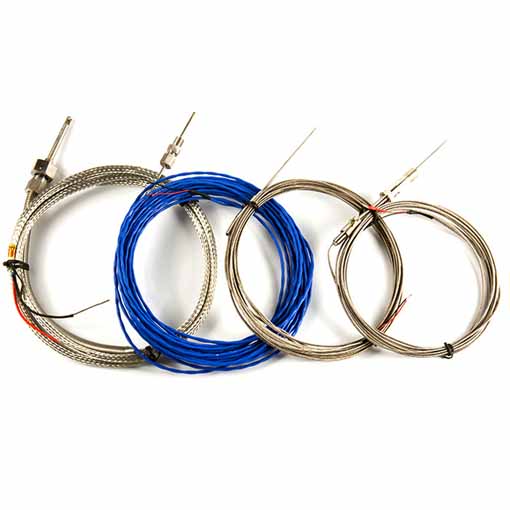Категории продуктов
- Тепловой выключатель 20
- Держатель блока предохранителей 36
- Датчик температуры 67
- Термовыключатель 64
- Автомобильный предохранитель 19
- Закрепить предохранители 7
- термопредохранитель 32
- предохранители для поверхностного монтажа 12
- термистор 22
- Держатель предохранителя для монтажа на печатной плате 27
- Жгут проводов 6
- Держатели лопастных предохранителей 17
- термостат 46
- Электрический предохранитель 14
Теги продукта
Поставщик прецизионных термопар
Оригинальный заводской E, Дж, Датчик термопары T используется для следующего определения температуры:: термометр, нагреватель воды, камин, печь, схема, RTD, холодный спай, печь, мультиметр, цифровой, промышленный.
Принцип работы E, Дж, Т -датчик термопары :
Когда есть два разных проводника или полупроводников A и B, образующие петлю, Два конца которых связаны друг с другом, Пока температуры в двух соединениях разные. Температура на одном конце, называется рабочим концом или горячим концом, и температура на другом конце - T0, называется свободным концом (Также называется ссылкой) или холодный конец. Электродвигательная сила будет генерироваться в петле. Направление и величина электродвижущей силы связаны с материалом проводника и температурой двух соединений. Это явление называется “термоэлектрический эффект”, и петля, состоящая из двух проводников, называется “термопара”. Эти два проводника называются “термоэлектроды”, и сгенерированная электродвижущая сила называется “Термоэлектромотная сила”.
Термоэлектромотивная сила состоит из двух частей электродвижущей силы, Одна часть - это контактная электродвижущая сила двух проводников, и другая часть - термоэлектромотная сила одного проводника.
Размер термоэлектромозной силы в E, Дж, T -термопарный датчик -датчик связан только с температурой материала проводника и двумя соединениями, которые составляют термопару., и не имеет ничего общего с формой и размером датчика термопары. Когда два электродных материала датчика термопары зафиксированы, Термоэлектромотивная сила - это разность функции двух температуры соединения T и T0.
который есть:
Эта связь широко использовалась в фактическом измерении температуры. Потому что холодный соединение T0 постоянно, термоэлектромотивная сила, генерируемая E, Дж, Термопара меняется только с температурой горячего соединения (Конец измерения), то есть, Определенная термоэлектромочная сила соответствует определенной температуре. Мы можем достичь цели измерения температуры, если мы используем метод измерения термоэлектромотивной силы.
Основной принцип измерения температуры термопары заключается в том, что два проводника разных компонентов образуют закрытый петлей. Когда на обоих концах есть градиент температуры, будет ток, проходящий через петлю. В это время, Существует электроэнерго-термоэлектромотная сила между двумя концами, который является так называемым эффектом Seebeck. Два однородных проводника с разными компонентами являются термоэлектроды, Конец с более высокой температурой - это рабочий конец, Конец с более низкой температурой - свободный конец, и свободный конец обычно при определенной постоянной температуре. В соответствии с функциональной взаимосвязью между термоэлектромозной силой и температурой, Сделано таблица индекса термопары;
Таблица индекса получается, когда температура свободного конца составляет 0 ℃, и разные датчики термопарса имеют разные индексные таблицы.
Когда третий металлический материал подключен в термопара, до тех пор, пока температура двух соединений материала одинакова, Термоэлектрический потенциал, генерируемый термопары, останется неизменным. То есть, Это не влияет на доступ третьего металла в петле. Поэтому, Когда термопара измеряет температуру, Измерительный прибор может быть подключен, и температура измеренной среды может быть известна после измерения термоэлектромозной силы. Когда термопара измеряет температуру, температура его холодного соединения (Измерительный конец - горячий конец, и конец, соединенный с цепи измерения через свинец, называется холодным соединением) требуется для поддержания той же температуры. Его термоэлектрический потенциал пропорционален измеренной температуре. Если (среда) температура холодного соединения изменяется во время измерения, это серьезно повлияет на точность измерения. Принять определенные меры для компенсации на холодном соединении, и влияние, вызванное изменением температуры холодного соединения, называется Компенсация холодного соединения термопары является нормальным. Выделенная компенсационная проволока для подключения с измерительным инструментом.
Метод расчета датчика термопары. Компенсация холодного соединения:
От Millivolt до температуры: Измерить температуру холодного соединения, преобразовать его в соответствующее значение Millivolt, Добавьте его к значению Millivolt термопары, и рассчитать температуру;
От температуры до милливолта: Измерьте фактическую температуру температуры холодного конца, соответственно, С точки зрения Millivolts, После вычитания полученных значений MV, Чтобы получить температуру.
Оригинальный заводской E, Дж, Датчик термопары T используется для следующего определения температуры:: термометр, нагреватель воды, камин, печь, схема, RTD, холодный спай, печь, мультиметр, цифровой, промышленный.

Бронированная термопара диаметром 3 мм. + Розетка J-типа

Pt100 e, Дж, T Датчик температуры датчик

Горячий бегун термопары

Высокая температурная термопару с высокой температурой
Связаться с нами
Жду вашего письма, мы ответим вам в течение 12 часы с ценной информацией, которая вам нужна.
 English
English العربية
العربية Български
Български 粤语
粤语 中文(简体)
中文(简体) 中文(漢字)
中文(漢字) Nederlands
Nederlands Suomi
Suomi Français
Français Deutsch
Deutsch Ελληνικά
Ελληνικά Magyar
Magyar Italiano
Italiano 日本語
日本語 한국어
한국어 Polski
Polski Português
Português Română
Română Русский
Русский Slovenščina
Slovenščina Español
Español Svenska
Svenska ภาษาไทย
ภาษาไทย Türkçe
Türkçe Tiếng Việt
Tiếng Việt

